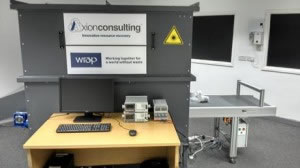Automation boost for packaging recycling
The recycling of plastic food packaging could be significantly increased in coming years following a research project that has developed an automatic sorting process.
Every year the UK produces an estimated 180,000 tonnes of waste polypropylene (PP) pots, tubs and trays. More than 60% of this comprises food contact packaging, with the remaining 40% consisting of non-food applications, such as cleaning products or cosmetics.
Under European food packaging regulations only PP that has been in prior contact with food can be recycled into new food grade PP.
Manual sorting is simply too expensive
Axion chemical engineer Richard McKinlay
Technical consultancy Axion Consulting, on behalf of the Waste and Resources Action Plan (WRAP), has developed an automatic so rting process that uses diffraction gratings to identify and separate PP that has been in contact with food from that which has not.
rting process that uses diffraction gratings to identify and separate PP that has been in contact with food from that which has not.
The process involves marking food contact PP packaging with lines (a diffraction grating) that can be scanned by a laser to reflect a specific pattern. The pattern is then captured by a camera connected to a computerised image recognition system that is able to identify the marked food contact PP packaging.
“This represents an innovative application of existing technology that could revolutionise any food contact plastic recycling in offering a commercially-viable automated solution,” said Axion chemical engineer Richard McKinlay.
“Manual sorting is simply too expensive.”
Axion estimates the total capital cost for a single diffraction grating sorting unit, including conveyors and ancillary equipment, at £500,000 with a potential payback within four years. Its report on the research project states that this payback period ‘should represent a good investment opportunity for a Plastics Recovery Facility (PRF) operator or a potential food grade reprocessor processing bales of sorted PP packaging’.
Equipment used in the demonstration was built to bespoke requirements by Axion’s engineering team. Items such as the camera and conveyor were all sourced separately from a variety of suppliers and put together to create what was needed for the pilot project. Image processing software was also developed to identify diffraction gratings on food packaging.
The technique developed in the pilot is potentially applicable to other polymer types, particularly high density polyethylene (HDPE) and polyethylene terephthalate (PET) packaging.
“Although we focussed heavily on PP for this project, using this technology initially to sort HDPE milk bottles could be advantageous,” said Axion senior consultant Liz Morrish.
“Once it has been shown to work on this material, it may give the industry more confidence to invest further to allow the technology to be used on PP. Diffraction gratings are not yet ready for use commercially until a full industry-wide solution has been developed and commercialised.”


































